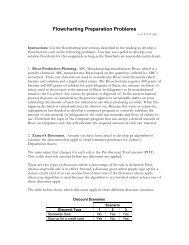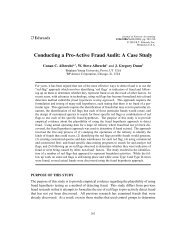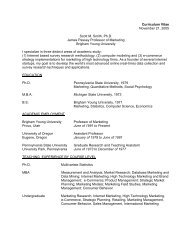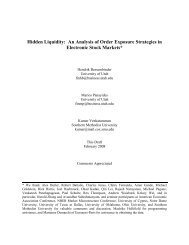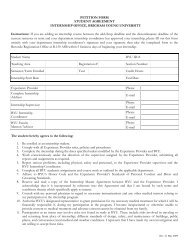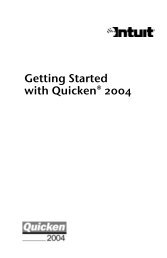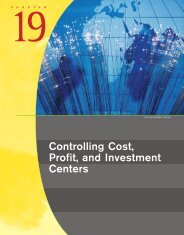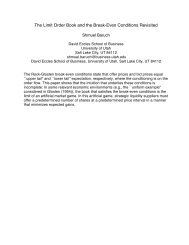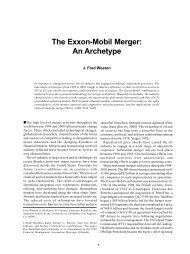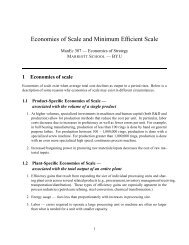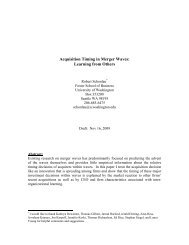why do firms go public? - Marriott School
why do firms go public? - Marriott School
why do firms go public? - Marriott School
Create successful ePaper yourself
Turn your PDF publications into a flip-book with our unique Google optimized e-Paper software.
IPO proceeds from their sample are from secondary shares. Examination of their Table II, Panel A<br />
(pg. 25 of their 2005 working paper version at http://ssrn.com/abstract=610988) shows that from<br />
1990-2003, nearly 31% of Argentinean IPOs, 30% of Portuguese IPOs, and 23% of Spanish IPOs<br />
consisted of all secondary shares. In these cases, it is clear that at least some insiders are cashing<br />
out. For other countries, such as Hong Kong (0.4%), Taiwan (0.4%), and Japan (0.6%), very few<br />
IPOs are all-secondary share issues. Interestingly however, Japan has the highest percentage of<br />
combined (primary and secondary shares offered) IPOs at 85.8%. The combined IPOs for Japan<br />
account for 53.4% of the primary proceeds and 34.3% of secondary proceeds (their Table II, Panel<br />
B) of all Japanese IPOs. As displayed nicely in Kim and Weisbach (2005) for a broad international<br />
panel of IPOs, the cash-out hypothesis is valid for some subsets and not for others.<br />
To allow more dispersion of ownership<br />
Chemmanur and Fulghieri (1999) argue that IPOs broaden the ownership base of the firm.<br />
In their model, the benefits of an IPO are contrasted with the lower information-production costs<br />
of being privately-held. Pagano et al. (1998) argue that the increased share liquidity of being<br />
<strong>public</strong> creates value for IPO insiders according to market microstructure literature. Benninga,<br />
Helmantel, and Sarig (2005) and Pastor, Taylor, and Veronesi (2009) present models in which the<br />
IPO decision is a balance of diversification benefits and private benefits. Bodnaruk, Kandel,<br />
Massa, and Simonov (2008) find empirical support for these models showing that <strong>firms</strong> with less<br />
diversified owners are more likely to <strong>go</strong> <strong>public</strong>.<br />
Pagano et al. (1998) test the dispersion hypotheses by arguing that riskier <strong>firms</strong> should be<br />
more likely to <strong>go</strong> <strong>public</strong> and that controlling shareholders should sell a large portion of their<br />
shares either in the IPO or shortly thereafter. (Note their second test also can apply to the cash-out<br />
hypothesis.) They find that controlling shareholders divest very little in the IPO (-3.2%) and<br />
11



